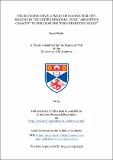Files in this item
The economic development of second-tier city-regions in the United Kingdom : using “absorptive capacity” to theorise the “firm-territory nexus”
Item metadata
| dc.contributor.advisor | Maclennan, Duncan | |
| dc.contributor.author | Waite, David Andrew | |
| dc.coverage.spatial | iv, 213 | en_US |
| dc.date.accessioned | 2015-07-28T15:35:16Z | |
| dc.date.available | 2015-07-28T15:35:16Z | |
| dc.date.issued | 2015-11-30 | |
| dc.identifier.uri | https://hdl.handle.net/10023/7070 | |
| dc.description.abstract | The economic development challenges facing second-tier city-regions in the United Kingdom reflect a critical dimension of policy debates concerning spatial rebalancing. The integration of multi-location firms at second-tier territorial contexts is an important aspect of rebalancing narratives, and this thesis examines what such integration may entail for the economic development of these places. Given the label of the “firm-territory nexus” by other economic geographers (Dicken and Malmberg, 2001), integration brings into focus a complex set of factors, processes and conditions. In order to grapple with and order such complexity, the conceptual framework of city-region absorptive capacity has been proposed and developed in this research. Four case studies across two second-tier UK cities, Edinburgh and Manchester, comprising interviews with elites and the collection of extensive documentary material, provides the empirical material for framework development. The research hinges on an analytical process that: first, deploys the functional form of “absorptive capacity” to provide language and broad parameters by which to approach the empirical object; and second, generates abstract categories from the empirical data to flesh out a contextually sensitive conceptual framework. Network position relative to London and labour appear as important integrating mechanisms across the case studies, though the conceptual framework demonstrates contingencies in terms of territorial and relational processes, shifting moments of structure and agency, and the overlapping institutional mosaics at play. By providing portraits of city economies in the middle ground of global economic networks, the need to articulate economic geographies of the “outside” and “inside” are also given emphasis. | en_US |
| dc.language.iso | en | en_US |
| dc.publisher | University of St Andrews | |
| dc.subject | Absorptive capacity | en_US |
| dc.subject | Firm-territory nexus | en_US |
| dc.subject | Embeddedness | en_US |
| dc.subject | Edinburgh | en_US |
| dc.subject | Manchester | en_US |
| dc.subject | Critical realism | en_US |
| dc.subject.lcc | HC260.E44W2 | |
| dc.subject.lcsh | Great Britain--Economic conditions--21st century | en |
| dc.subject.lcsh | Manchester (England)--Economic conditions--21st century | en |
| dc.subject.lcsh | Edinburgh (Scotland)--Economic conditions--21st century | en |
| dc.subject.lcsh | Economic development--Great Britain | en |
| dc.title | The economic development of second-tier city-regions in the United Kingdom : using “absorptive capacity” to theorise the “firm-territory nexus” | en_US |
| dc.type | Thesis | en_US |
| dc.type.qualificationlevel | Doctoral | en_US |
| dc.type.qualificationname | PhD Doctor of Philosophy | en_US |
| dc.publisher.institution | The University of St Andrews | en_US |
| dc.identifier.doi | https://doi.org/10.17630/10023-7070 |
This item appears in the following Collection(s)
Items in the St Andrews Research Repository are protected by copyright, with all rights reserved, unless otherwise indicated.

